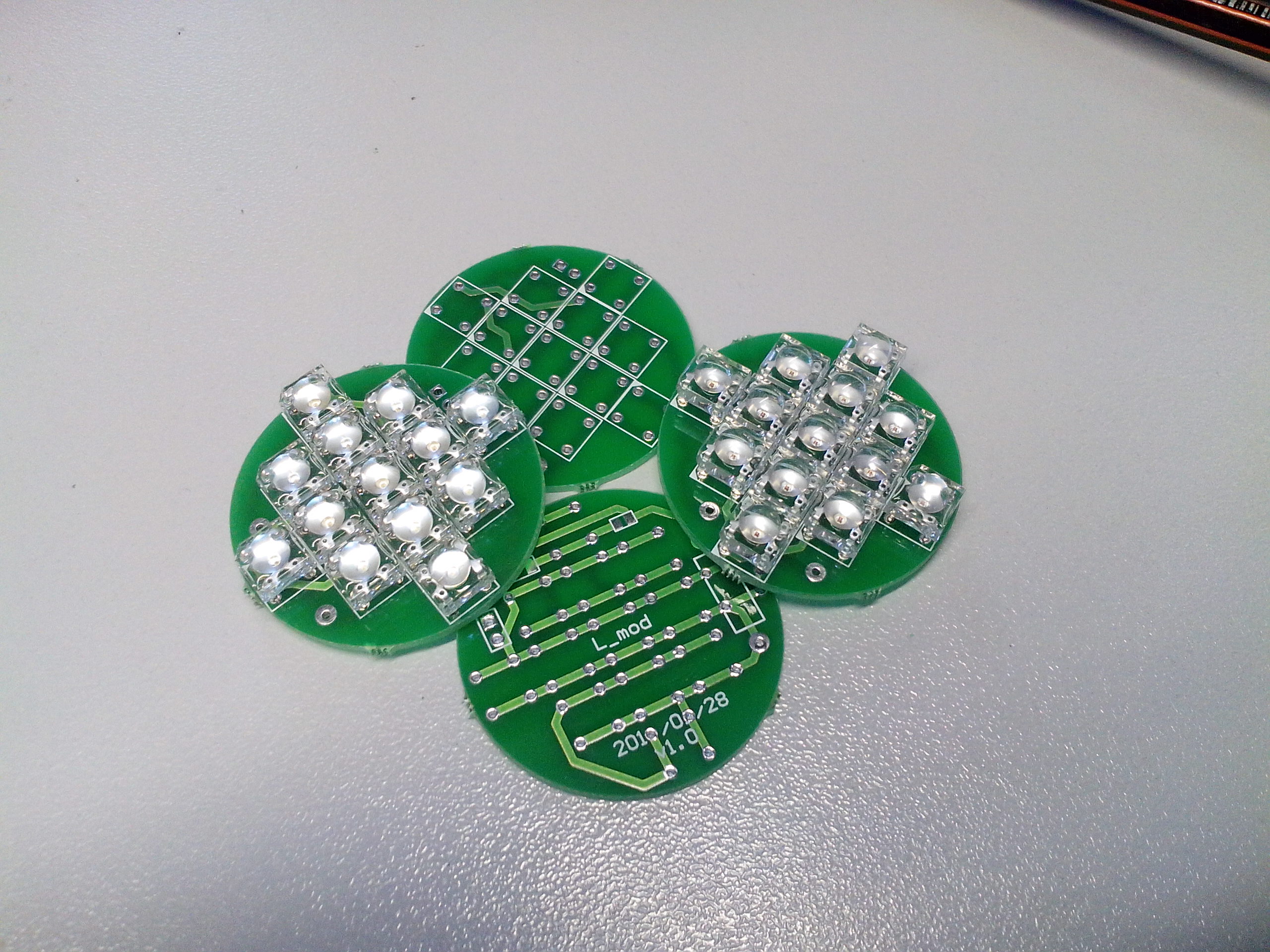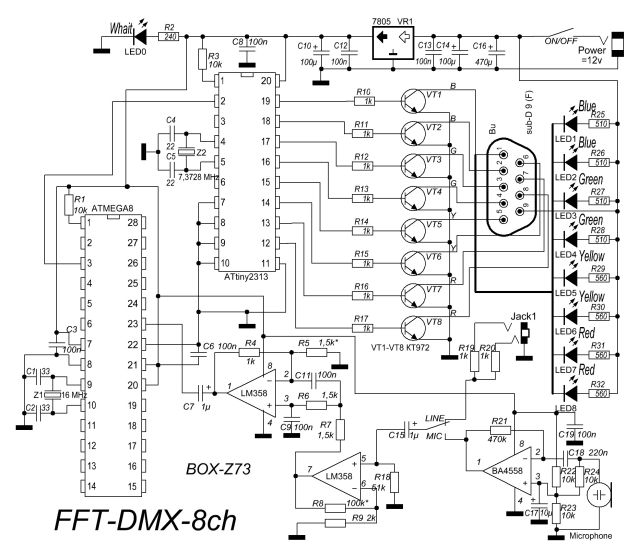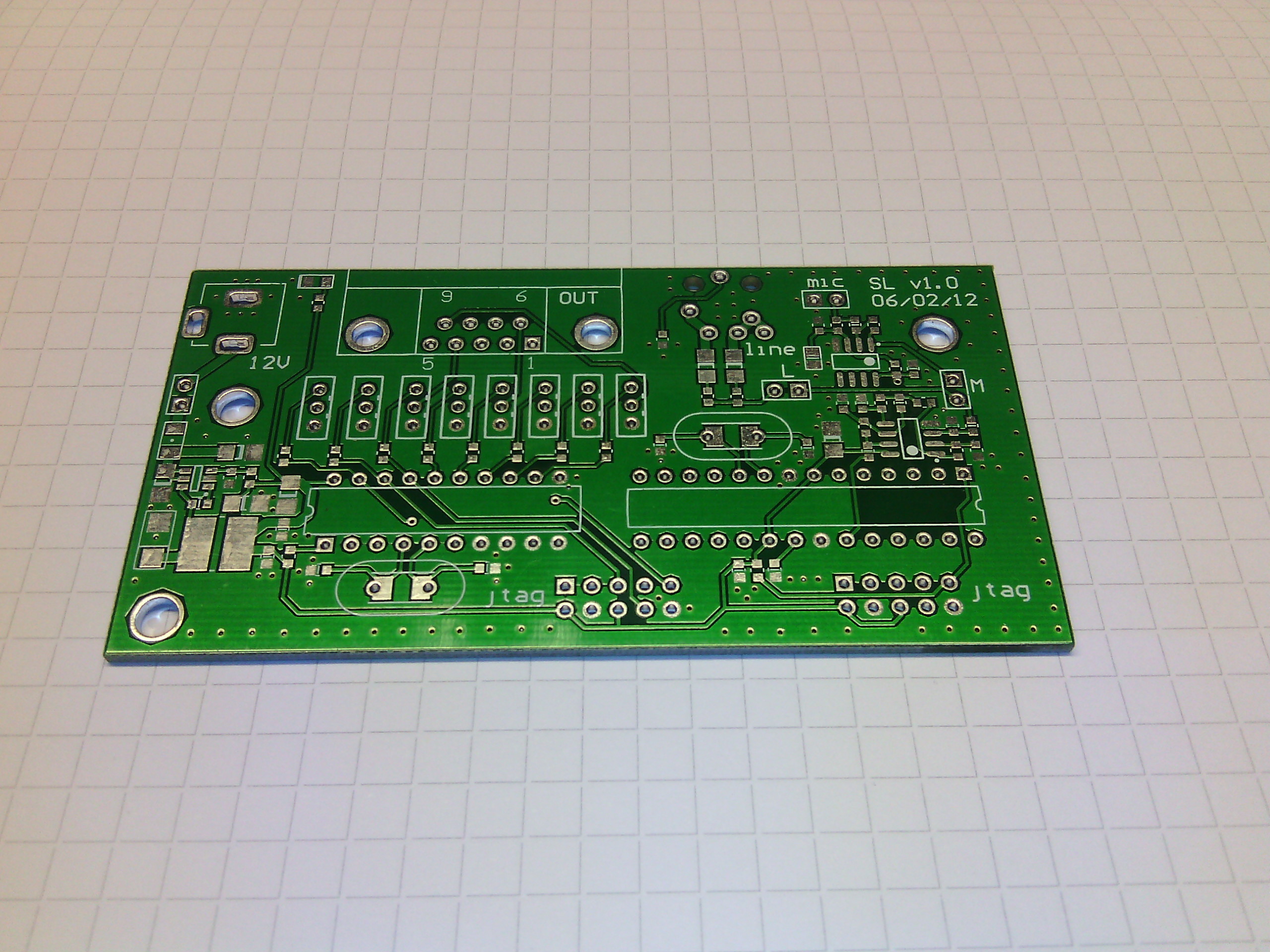Color organ installation "Baby-001"
Hi, Habr!

It has long dreamed of creating a color organ. I have always been attracted to blinking lights to the music. At one time, I made a circuit on thyristors - this is a classic, quite simple to repeat circuit. It worked pretty well after the selection of filters. For school disco, coupled with a strobe this is enough. Now I wanted to do something more worthwhile, with a minimum of expenses for money and time. Under the cut you will find CMU according to the “Baby-001” scheme.
Having read a bit of theory about how to select the necessary frequencies from the signal spectrum for the implementation of a color organ installation, I realized that Fourier transforms and others are not for me. The solution came simple - to repeat the finished circuit, and dissolve the board and come up with the design of the lamps yourself. After a brief search, the “Baby-001” circuit was found on two controllers. Of course - this is not the scheme that is optimal, but from the reviews and comments on several sites, I realized that this is exactly what is needed.

Without going into the details of the software (I took it as a ready-made module) I spread the board, it turned out something like:

He soldered, connected four LEDs, tapped on the microphone, the LEDs blinked obediently. The simplest part was made. Not a tricky thing to repeat someone's development.
Then I thought for a long time how to make lamps. It was decided to use four channels, so it was necessary to have four LED lights (by the way, chandeliers with 4 light bulbs are on sale). Looking through the tape of my sellers on ebay, I came across the superbright “Piranha” LEDs for some funny money, something like $ 14 per 100pcs (25 pcs. Of different colors). This gave me the idea to make LED lamps in the finished ceiling. While the order was coming from distant China, fees were made:

Having connected the resulting LED module to 12V (naturally through a resistor), everything turned out even more elegantly than I expected. Boards divorced under ceiling lights for halogen lamps.
In order not to draw extra wires, I use only a microphone, so when playing any music (even from the phone) we get flashing lights.
Here is a small video (link) of how everything works after installation (I apologize for the extraneous sounds on the video, in the form of a child's voice, I really liked my daughter).
dl.dropboxusercontent.com/u/25037786/habr/CMU/VID_20130317_120659.3gp
It is flooded on youtube, but it is difficult to play.
All wires are hidden in a box (which was previously conceived simply as part of the design), the lamps are embedded there too. The video may not be clearly visible, but the frequencies are quite well allocated, that is, blinking occurs beautifully to the music.

It has long dreamed of creating a color organ. I have always been attracted to blinking lights to the music. At one time, I made a circuit on thyristors - this is a classic, quite simple to repeat circuit. It worked pretty well after the selection of filters. For school disco, coupled with a strobe this is enough. Now I wanted to do something more worthwhile, with a minimum of expenses for money and time. Under the cut you will find CMU according to the “Baby-001” scheme.
Having read a bit of theory about how to select the necessary frequencies from the signal spectrum for the implementation of a color organ installation, I realized that Fourier transforms and others are not for me. The solution came simple - to repeat the finished circuit, and dissolve the board and come up with the design of the lamps yourself. After a brief search, the “Baby-001” circuit was found on two controllers. Of course - this is not the scheme that is optimal, but from the reviews and comments on several sites, I realized that this is exactly what is needed.

Without going into the details of the software (I took it as a ready-made module) I spread the board, it turned out something like:

He soldered, connected four LEDs, tapped on the microphone, the LEDs blinked obediently. The simplest part was made. Not a tricky thing to repeat someone's development.
Then I thought for a long time how to make lamps. It was decided to use four channels, so it was necessary to have four LED lights (by the way, chandeliers with 4 light bulbs are on sale). Looking through the tape of my sellers on ebay, I came across the superbright “Piranha” LEDs for some funny money, something like $ 14 per 100pcs (25 pcs. Of different colors). This gave me the idea to make LED lamps in the finished ceiling. While the order was coming from distant China, fees were made:

Having connected the resulting LED module to 12V (naturally through a resistor), everything turned out even more elegantly than I expected. Boards divorced under ceiling lights for halogen lamps.
In order not to draw extra wires, I use only a microphone, so when playing any music (even from the phone) we get flashing lights.
Here is a small video (link) of how everything works after installation (I apologize for the extraneous sounds on the video, in the form of a child's voice, I really liked my daughter).
dl.dropboxusercontent.com/u/25037786/habr/CMU/VID_20130317_120659.3gp
It is flooded on youtube, but it is difficult to play.
All wires are hidden in a box (which was previously conceived simply as part of the design), the lamps are embedded there too. The video may not be clearly visible, but the frequencies are quite well allocated, that is, blinking occurs beautifully to the music.
')
Source: https://habr.com/ru/post/212651/
All Articles